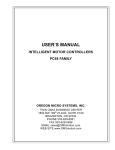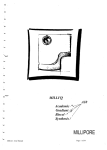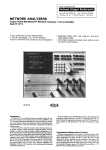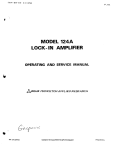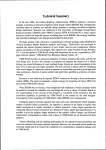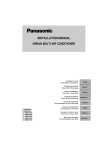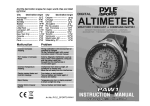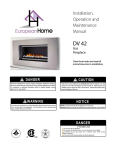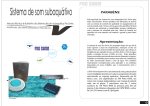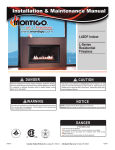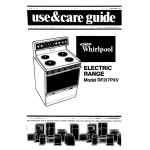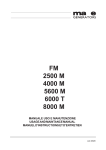Download PM 6611 80MHz Universal counter PM 6612 80MHz Counter timer
Transcript
Counters lAd counterIlimers PM6611 80MHzUniversalcounter PM6612 80MHzCountertimer PM6613 250MHzUniversalcounter PM6614 520MHzUniversalcounter PM6615 16HzUniversalcounter PM6616 1.36HzUniversalcounter WideIrequency rangesIrora10Hzupto Highsensitivity 0110mV 80MHz...250MHz...520MHz...16Hzand 1.36Hz Hightime-resolution ollDOns Twodifferentinputs.respectively lF andRF. speciallydesigned lor noise-lree 9 digit~Iana~ displayensures thebest resolution Wlthoverflow measurements Theautomatic PlI-diodeattenuator in theRF cha ERnelDivIs: . Good por1abilltythrough balteryoptlon and compact lightweight construction - all 01operation - Moisesuppression - Overloadprotection 178 Choice014 X-taloscillaters IFdisplayoffset With compliments Helmut Singer Elektronik www.helmut-singer.de [email protected] fon +49 241 155 315 fax +49 241 152 066 Feldchen 16-24 D-52070 Aachen Germany lEt Bus-line Interface BCD outputanddigltal-to-analog converter outputoptions. tor digitalprint-outor analog recordlng of measuring data Easeof operation.tbanks to excellent ergonomie lay-outandautomated functions. whiletheverybrightplanardisplayensures thebestreadability Type Frequency P8riod .~ Number SOMHz 250MHz 520MHz + 1.3GHz Periodsv. 1GHz Multiple Totalizing Time Ratio of Counts interval PM 6611 PM 6612 PM 6613 I PM 6614 PM 6815 PM 6616 Table 1. Performance survey 01 PM 6610-series 01 universal counters WIDE VERSATILITY AND FLEXIBILITY TC MEET YCUR PARTICULAR REQUIREMENTS The PM 661 O-series forms a family of live universal frequency counters: 80MHz. 250M Hz. 520MHz. 1 GHz and 1.3GHz plus one 80MHz counter/timer. All models measure a wide variety of frequency- end time- related parameters such as: FREQUENCY, PERIOD-AVERAGE, MULTIPLE-RATIO, TOTALIZING of counts, SELF-CHECK (and TIMEINTERVAL PM 6612 only). They further ofter a facility as stopwatch. The universalcounter PM 6611 and the counter/time PM 6612. both ranging up to SOMHz. are designed tor general purpose frequency and time measurements in researchand deveJopmentproduction testing - maintenance and repair - and education. The universal countersPM 6613. PM 6614. PM 6615 and PM 6616 have specifically been designed tor high frequency measurements. on telecommunication- broadcast- and TV equipment.The rechargeable battery unit plus the compact and lightweight construction make all these units very suitable tor portablefjeld use. Choice of time-base oscillator There is choice of 5 X-tal oscillators. see fable 2. In this way the individual stability requirement can be met economically and also upgraded. if necessary at a later stage. By means of the external reference input. use ca" be made of a frequency standard. C -,n tory instruments to fjeld applications. This has been achieved by developing ovencontained crystal oscillators with extremely low power consumption. '-' .II:> ./1..:J LC:J ,,'- The high-stability ovenized time-base options therefore can also be used with the internalbatterypack. No warmup times are thus neededwhen changing locations with a counter having astability much higher than that of TCXO's(temperaturecompensatedX-tal oscillator).The batterycapacity is sufficient tor 24 hours stand-by operation. This makes these counters the most suitable for portable fjeld service use currently available. Fig. 1 Mains (Iine voltage) or battery supply Each instrument is equipped tor the following alternative supply voltages: Table 2. Choice of time-base oscillators PM 661./..Y8f8ion IncludingIime-bUl: 01 ~ ~M N77 02 vMion PM 8878 03 Y8fSion PM 9879 ~ verlion PM 8690 8g8in8t: Type: 8I8M8Id TCXO controMed ~ STAIILITY ~ Aeeing; pro,ortjonilly < 5,,10-' per month < 1 ,,10-' per.-nth < 1 ,,10-' per month <1x10-. <1.~-' <3x10-' 06 verlion PM 9891 - propor(jonal1y PfOPOftionIIIy controHed < 1.5,,10-. per 24h' < 5,,10-'0 per 24h' <1x10-' <3K~O-. <IK10-' <..~-. < 1 - 10-. < 3- ,.-. < 3x te- <1,,10-. <1,,'0-. <1x10-' <5-10-'0 <5x10-10 - - ~ T~: O'C...50'C. r8f. 10 +25'C Ch8nge in m-unng 8nd I4IPp/y mode; tine/int. b8n8v/ en DC 12V...28V Instantaneous base high stability time The PM 661 O-series, break new ground in the ares of portable counters by extending the instantaneous high stability of labors- Unevolt8ge;z1~ W8nn-UP-- 10 r8IOh1 ,,10-' , ."., 72" ., .x .~ < 1~ < 11..-n ...;;.-; 179 With compliments Helmut Singer Elektronik www.helmut-singer.de [email protected] fon +49 241 155 315 fax +49 241 152 066 Feldchen 16-24 D-52070 Aachen Germany . Front panel protection cover MORE ACCURATE AND RELIABLE LF AND RF FREaUENCY MEÄSURE. MENTS Whilst the basic accuracy of any counter is %1 digit %the time base error. it is not always realized that noise or interference can cause false counting and can lead to significant errors Analog output PM 9675 The digital-to-analog converter PM 9675 provides a high resolution analog output tor recording frequency stabilities of oscillators. filters and crystals on a Y-t chart recorder. In f~uency coQIJOI systems having analog feed back the DAC serves as an extremely accurate frequency-voltage converter. The PM 9675 permits conversion of any three con. secutive digits out of the total of 9. or the two least significant digits. As such it functions as a magnifying glass to focus on just thaI part of the read-out which is most important (see fig. 1). LF-input Forthe low frequency input (A), the co,,-, . tinuous attenuation is set manually by the . sensitivity c6ntro1 for universal wave-'. - . Jorms up to 80MHz. For accurate LF may be switched oon.This filter o'ej~ HF nojse or interference,having ampli- - . r tudes much higherthan th4t of the input signal under test (see curve). 40 ~. r '", ao -..'~ 0 . 0 Fig.4. Thil ~ ., * Carrying case PM 9678 To protect the whole instrumentduring transportor fjeld use.an ever-ready;case PM 9672 can be orderedas an option.1 extra. 180 5 ~ fIwqu.nc)r~. ...'ttiw~... ~ '., ,{ -~ on The special RF-input The flexibility is boosted by choice ot operating mode. In the offset mode. the conversion ot 500 produces a zero analog output; whilst 000 gives a mid-scale deflection. Bus Interface PM 9678 The serial data output-unit PM 9676 enables data processing by conn8Cting the instrument to a standard bus-fine. . AttenU8tion dB The nOf'Tnalmode converts 000 into a zero analog output and 999 into a tull scale output. For a display changing between 9.9999999 end 10.0000000MHz it is possibleto record the frequencyon the center of the strip chart. rather than having the output shifting between zerO and full scale. "' measurements.the built-in low-p.aSS"filtei.~ (8) - BCD output PM 9674 Theoptionalcircuit board PM 9674 giv. BCD-data in a parallel format for connection to a standardprinter such as the Philips PM 2466. Standard accessories Operation/servicemanual une cord channel- IF (Display) off-set unit PM 9868 The optional circuit board PM 9668 enablesthe addition or subtractionof a programmablevalue to the measuredvalue. In this way it allows the 8 most significant digits to be off-set This unit offers the external select;on between two pre-programmabteoff-set valu8S. to an amplitude just above the value of the trigger window. At the same time, noise and interference are suppressed so much that they cannot span the trigger window. False counts from noise, interference. etc. are thus eliminated in these counters. This optimum input matching (which cannot be achieved with conventional counters having decade-step attenuators) ensures that the accuracy as measured is the maximum attainable accuracy of %1 digit %the time base,. error. .- input 45...440Hz -External banery: 11.8...28VDC (tor mobile use) - Internal rechargablebanery unit (tor portableuse) Rackmount adapters PM 9669 The counters can easily be fitted in a standard19" rack by the use of the rack adapterPM 9669/01 or PM 9669/02 for one respectivelytwo cou~ers. RF - Une voltage: 110...240VRMS; models PM 6613...PM 6616 features an, au:tomatic multistage PIN-Diode attenu- ' ator circ.Qit.In addition to the noise suppression this gfv. benefits : With the PM 6610-series. the superior accuracy tor both lF- and RF- measurements js due to the improved triggering with noise- and interference rejection. This break-through in trigger performance hai been obtained by two specially designed input- and trigger channels optimized respectively tor lF- and RF-signal processing. The fig. 1a in the introduction indicate how distortion or nolle in . conventional counter can cause the signal to pass through the trigger window (hysteresis band) and hence give false counts. The Philips PM 6610-series of counters feature continuously variable input attenuation. which reduces the input signal the following user 1. wide dynamic input voltage range 2. operation 3. ease high of overload protection ~ ,. Wlde input voltag.-range The use of PIN.diode attenuatorsand' , other state of the art componentsin the RF stages ensuresperfect triggering at input levels between - 27dBm and +35dBm (10mVRMS...12VRMS)' Automatic triggering The operator need not concern himself with sening the amplitude tor optimum triggering. The AUTOMATIC ATTENUATION of input signals ensures the beBt triggering without human intervention. With compliments Helmut Singer Elektronik www.helmut-singer.de [email protected] fon +49 241 155 315 fax +49 241 152 066 Feldchen 16-24 D-52070 Aachen Germany R F-input protection Unlike conventional AGC-circuits (where the gain js controlled. but where the fu" input voltage is applied to the amplifier input). the multi-stage PIN.Oiode circuit really ATTENUATES the input signal. This ensures that powerful signals are strongly reduced before they appear at the input of the sensitive amplifier. The attenuator functions as very fast RF INPUT PROTECTION up to a high +35dBm (12V) signal level. It is evident that an efectronic overload protection reacts much fester than the older mechanical methods such as RFfuses or relays. In addition the latter do not otter protection against modulatedor pulsed RF. since they respond to the average signal value. Low level R F me.surements In conventional counters, too low an input signal often causes stable and reproduceable yet fully erroneous meaSUr8ments. Such measurements are eliminated in these counters by a distinct switch-off point. A built-in level detector permits counting only when the input signal is of sufficient amplitude ( ~ 10mV). EASE OF OPERATION worries about the recharging time. The charging current is automatically controlled to protect the batteries against overcharge. For mobile fjeld US8.the 11.8.. .28V power receptacle enabtes supply from external batteries (tor instance from the cigarette lighter socket in your car). SINGLE PERIOD (All MODELS) R8ng8 100n8...1008 R~ution 100ns Accuracy :1 count :time beS8- :t:triQ98r_O Input ORDERING PROCEDURE ch8nnetA PERIOD AVERAGE (ALL MODELS) PM 681./01; 80/250/520/1000/1300 MHz Counter,including time baseoscil. R8nge 1Hz...10MHz latorPM 9677 PM 681./02: idem, but including 10Hz...10MHz (for sinewB"es) PM 9678 Periods 8v8reged (N) PM 881./03; idem, but including 108 Bnd 10. PM 9679 PM 881./04: idem, but including R..olution 100ns/N PM 9690 PM 661./05: idem. but including Accur.oy :1 count :ttime be.. 8rror. PM 9691 trigger "'0" PM "9688: If off-set unit :t N PM 9889/01: 19-in rack mount adapter to fit one unit Input PM 9689/02; 19.in rack mount adapter ch8nnel A to fit two units COUNT(ALL MODELS) PM 9872: Carryingcase PM 9873: Battery/rechargingunit R8nge 1 10. PM 9874; BCD-outputunit PM 9675; Digital-to-Analogconverter Count 8ccumulation PM 9876: Bus-lineinterface(IECTC66) during manua' start/stop onterv81 The time base oscillators.PM 9678, PM 9679. PM 9690 and PM 9691 can Pul.. p8ir r.solution be ordered also separately. to upgrade 12M the counterafterwards. Input Likeothernew instrumentsin the Philips range.thesecountershavereceiveda Jot of attentionfrom ergonomicdesign specialists to get an unclutteredfront panel layout.which is weil humanengineered. Thecontrolsare placedso that operation It should be noted that the options is easilyunderstood.whilst the clear and PM 9673, PM 9674, PM 9675 and very bright 9-digit planar display gives PM 9676 CANNOTbe combined. readoutswith high last digit resolution. This afters quick and full control over your counter; a conveniencenot oftered by instrumentshaving autorangingand leIS digits. TECHNICAl SPECIFICATION channelA Note In Ihe Count Mode ttI8 lnemory is .utom.tlc.lI~ lWitched off TIME INTERVAl (PM 8812 ONlY) Range 111 10.. Raaolution easy to handle in fjeld UM Due to the high degree of integration. all models have the same compaC1 8nd lightWeight construction. For easy operation in the fjeld. a built-in type 01 battery unit keeps overall dimensions unchanged. Display blinking ja a warming that the banerychargeis low. To cornpleteyour measurement.10-15 minutes are left before rechargingia needed. The sealedlead-acid batterieseliminate damage tram complete discharge. Rechargingis possibletram the line or tram an externel DC sauce (at least 18V). . . FREQUENCY 100m Renee 10Hz...80MHz (PM 6811) 10Hz...80MHz (PM se1 2) 10Hz...250MHz (PM se13) 10Hz...520MHz (PM 5514) 10Hz...IGHz (PM se15) 10Hz...1.3GHz (PM 5818) Accur8CY Get. tlmes 10ms...108 (PM 6611. PM 8613...PM 8818) 1~...1~ (PM 8812) Gltetimes MlKtable In d8C8dest /f the RF.input on models PM 6613...PM 6616 i. uNd. Ih. 081. tim. is automatically multiplied wilh the Pfesc8ling fKtor . or 10011. :t:1count:t:limeb-. - :t:triQO8r -"" Inputs ch8nnets A 8nd B CHECK (ALL MODELS) 10MHz clock frequ8ncY inten:onnected to input A. Any m88auring funCtion n\8Y b8 88I8Cted. By using thia mode, the COUNT funcrion provid. . Itop-wetch facility ': I Accuracy . trigger error is ~ *3" 10-3 lor sinewaves with :t t counc :tUnte b8M _. lignel to noiM r8Iio of ~ 4OdB The built-in recharging circUlt IS fully Input. automatic. For the user, this means no RF channel(8) > 10MHz (PM 6613...PM 8818) LFchann" (A) 10Hz...80MHz(aI' modela) .. trigger for .ny w~.pe 2.5)( 10-'(V,..) .. , :t:li8n8I8Iope i. 181 With compliments Helmut Singer Elektronik www.helmut-singer.de [email protected] fon +49 241 155 315 fax +49 241 152 066 Feldchen 16-24 D-52070 Aachen Germany With compliments Helmut Singer Elektronik www.helmut-singer.de [email protected] fon +49 241 155 315 fax +49 241 152 066 Feldchen 16-24 D-52070 Aachen Germany MULTIPLE In tt\8 PM 6813...PM 8616 input 8 i. tt\8 RF input channe' with lutomatic anenuation. RATIO R8tio fA/fC: Time Inurvel STOP-cfl8nnef 8 (PM 8812 onlv) Frequency ringe 10Hz... 10MHz Pu'" ~ution SOn. minimum pul.. width Senaitivity 20mVR S Impedlnce: 1MQ/~5PF Coupiing: AC Attenuetion: continuou5iv yenlbl. ~ x1...x20 10Hz...80MHz 1kHz...10MHz (PM 8811) R8tio fA/fB: 10Hz..80MHz 10Hz... 10MHz (PM 8812) Rnlo tA or I/tC: 10Hz...250MHz Trigger mode: (PM 8813) 10Hz...520MHz 1kHZ...10MHz(PM 10Hz...1GHz (PM 8814) far lign-" hlving I duty f8QOf Oyerto8d yoltag. without damage: 25OVcc 220VRMS; up to 400Hz 12VRMS; >1MHz 8e15) 1kHz...10MHz 10Hz...1.3GHz ~ > 26%... < 75% n far lignel' hlying I duty fKtar < 25% u for lign", hlVing I duty f8Ctar > 75% 1kHz...10MHz (PM 8e16) 1kHz...10MHz Multiplier (N) 102 and 10. wilh CoffKt decimal pot", posilioning Accur8Cy = I count trigger error" 01 the lo_r = N Irequency Ratio m_urementa with a multIplier faetor N-10.,10.,10' end 108 (PM 8811, PM 6813...PM 6618) end N-10., 10' and 108 (PM 8812) are obtained in the FREOUENCY mode. uling the externat retar- input- 1- ff8Quency Input. This arrengement however. does not giye correct decimal point PO8itioning. RF Input (8) Frequency ringe: 5MHz...250MHz (PM 8813; 4 x preacel8d) 50MHz...520MHz (PM 8814; 8xPlW8C8i8d) 50MHz...1000MHz (PM 6615; 16 x p'ncaled) 8OMHz...1300MHz (PM 8818; 18K~) Dynamic input voltage range: 10mVÄMS 12VRMS (-27dBm... +35dBm) Imped.nce: SOO .A.nenuation: Continuoua by automltjc PIN.diode attenuetion circuit; mix 82dB Coupjing; AC VSWR: Ilwaya <2 AM tolerence: 9ß at ~ 5kHz moduletlon trequ~ 30% et ~ 1MHz moduletion trequency Ov.,told volt.g. without d.meg.: 12VRMS . INPUT CHARACTERISTICS Input A (all modell) Frequenc:yringe: 10Hz.80MHz. limiled 10 100kHz 1I internal low.pass fiher i. switched in Puls. resolution 6n. minimum pu'" width Sensitivity 1OmVRMS (20Hz...80MHz) JOrnVRMS (10Hz...20Hz) Impedenc.: 1MC//25pF Coupiing: AC AnenU8lion: contlnuously v8riable ~ x1...x400 Tri~ mode: ~ for ~ne~ h~ng e duty facu. > 25%. < 75% filor .ignel. heving e duty lecior < 25% lSIor ~naI. havlng e duty lactor > 75% Overloed vollege wilhout demege: 250V DC 220V~MS; up 10 400Hz 12VAMS' > 1 MHz Input B (Not available on PM 6611) Inpul B serve. in Ihe PM 8812 .. 'IOP chann" in lime.interval ~ents inpul lar rabo m881U~ts. 182 end- '- fl8Quency .A.bov. 980MHz. the a~tivitV charge display weIh lutomllic dec/mll point politioning Oisplly time 0.2...5s end ~ R_t: Pushing 'R.et' r~s the counter. ReI..ling'R_' st.u n- _I. Gete Ilmp: Indicates thlt meIn-gate is Of)8ned and count/ng tak. piece M~ory: Switchlble by push-buttOn. In the Count Mode, the memory is switched off end the bunon is uNd lor 'stlrt/stop' operlbon Power requlrementl Une vohage: 110/220V :15%; 45440Hz Consumption: depending on tYpe no. ClVStal oscillator and optionl approx. 15VA Maina intefference: below CISPR: 22/3. 29/2 and 4011 or via Internal battery PM 9673 or via Ext.nal DC sowce: vo/tlg. betw..n + 118V and + 28V consumption approx 8W. Approx. I00mA in STAND8Y position if an ovenItabilizld oscillator is mountld. Connector: 4 mm banana Environment" Temperalure: Slorage: -40"C... + 70"C Operating: O"C... +5O"C A.ttitude/barometer preaure: Stor.,e: 15000m (50000ft1/15.2kN/m2 Oper.tin,: 5~ (15000ft1/53.3kH/m2 HumidllY: 10...90% RH (2S"C d~inll Vibr.lion 1881: Accordint 10 lEt 88 Fc Bump teil: A.ccOfdint to lEt 88 Eb Handling le.t: A.ccordlng to lEt 88 Ec Tr.n8PQrt l88t: A.ccording 10 HLH-L88 of IM PM 8815 might drop to -24dBm (14mVRMS) at IGHz. FOt PM 8818 dyn.mlC reng. is 1OmVRMS...12V~MSfor trequenciea 150MHz...1GHz and 2OmV~MS'" 12VRMS tor trequenciea SOMHz...1.3GHz. Oimenaion. .nd wetght (w"h"d) 210"89 " 325mm (8.25" 35" 12.8-;n) 2.8kg (6.2Ib) Input C (Ext. ret. o8Oill8tor) Frequency range: 1kHz...10MHzRMS SensitivilY: 5O0mVRMS Impedance: approx. 10110 Counting: AC Overloed vollaga wilhoul damage: 5OVRMS A compi8telilt of ~lion.1 .~... for bochdie PM 8820-5."8' end th8 PM 8810.$8"" Ippearl OUTPUT CHARACTERISTICS 08C1I18tor output (rAr) X-lai frequency 10MHz Ampilluda: apt)rOx. 1VRMS; 098n Clrcuit Output im~nce: approx. 2000 Coupling: AC Ov8fload prollCtion: short circu,l ptoof - GENERAL Diapl8V Reed ~t: PI.n.,. 9 digits; 7 I89menU gaI dis- Option.' .cc8aaorl.. on. P8g8 1 98.






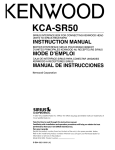
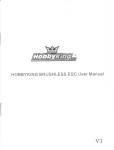

![ft.757gx ]i hf all mode computer aided transceiver](http://vs1.manualzilla.com/store/data/005735092_1-f8362b9c1e3279439f07a335507c2c8e-150x150.png)
